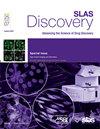基于过度磷酸化tau蛋白的阿尔茨海默病药物发现:tau蛋白聚集和细胞毒性抑制剂的鉴定
IF 2.7
4区 生物学
Q2 BIOCHEMICAL RESEARCH METHODS
引用次数: 0
摘要
阿尔茨海默病(AD)是一种神经退行性疾病,影响着全世界超过3000万人。认知功能进行性衰退的潜在原因是大脑神经元中的神经原纤维缠结(nft)。nft的时空分布预测了认知症状的进展。相反,老年斑淀粉样蛋白-β聚集体(AD的另一个主要生物标志物)与临床症状发展无关,这与接受抗a β免疫治疗的患者对认知功能的微不足道的益处是一致的。因此,迫切需要一种新的针对tau病理的药物发现途径。利用重组过磷酸化的tau蛋白(p‐tau),我们进行了荧光p-tau聚集实验,完成了100k化合物高通量筛选(HTS),并确定了p-tau聚集和细胞毒性的抑制剂。这种双重功能筛选产生了几种有效抑制p-tau聚集和细胞毒性的有效化合物。在这项工作中提出的结果是第一个针对高磷酸化tau细胞毒性的小分子化合物的HTS。在此筛选中发现的热门药物及其类似药物将在不久的将来开发,可能会在阿尔茨海默病和其他神经退行性病变的治疗开发方面取得突破。本文章由计算机程序翻译,如有差异,请以英文原文为准。
Hyperphosphorylated tau-based Alzheimer’s Disease drug discovery: Identification of inhibitors of tau aggregation and cytotoxicity
Alzheimer’s disease (AD) is a neurodegenerative disorder that affects more than 30 million people worldwide. Underlying the progressive decline of cognitive functions are the neurofibrillary tangles (NFTs) in neurons of the brain. The spatiotemporal distribution of NFTs predicts the progression of cognitive symptoms. In contrast, the senile plaques of amyloid-β aggregates, another major biomarker for AD, do not correlate with the clinical symptom development, consistent with the negligible benefits to cognitive functions in patients receiving anti-Aβ immunotherapies. A new drug discovery avenue targeting tau pathologies is therefore urgently needed. Using a recombinant hyperphosphorylated tau (p‐tau) that presents characters key to the disease, e.g., formation of neurotoxic aggregates, we conducted a fluorescence p-tau aggregation assay and completed a 100K-compound high-throughput screen (HTS) and identified inhibitors of p-tau aggregation and cytotoxicity. This dual functional screen resulted in several potent compounds that effectively curbed both p-tau aggregation and cytotoxicity. Results presented in this work are the first HTS for small-molecule compounds that target the cellular toxicity of hyperphosphorylated tau. Top hits found in this screen and their analogues to be developed in the near future may lead to breakthroughs in the therapeutic development for Alzheimer’s disease and other neurodegenerative tauopathies.
求助全文
通过发布文献求助,成功后即可免费获取论文全文。
去求助
来源期刊

SLAS Discovery
Chemistry-Analytical Chemistry
CiteScore
7.00
自引率
3.20%
发文量
58
审稿时长
39 days
期刊介绍:
Advancing Life Sciences R&D: SLAS Discovery reports how scientists develop and utilize novel technologies and/or approaches to provide and characterize chemical and biological tools to understand and treat human disease.
SLAS Discovery is a peer-reviewed journal that publishes scientific reports that enable and improve target validation, evaluate current drug discovery technologies, provide novel research tools, and incorporate research approaches that enhance depth of knowledge and drug discovery success.
SLAS Discovery emphasizes scientific and technical advances in target identification/validation (including chemical probes, RNA silencing, gene editing technologies); biomarker discovery; assay development; virtual, medium- or high-throughput screening (biochemical and biological, biophysical, phenotypic, toxicological, ADME); lead generation/optimization; chemical biology; and informatics (data analysis, image analysis, statistics, bio- and chemo-informatics). Review articles on target biology, new paradigms in drug discovery and advances in drug discovery technologies.
SLAS Discovery is of particular interest to those involved in analytical chemistry, applied microbiology, automation, biochemistry, bioengineering, biomedical optics, biotechnology, bioinformatics, cell biology, DNA science and technology, genetics, information technology, medicinal chemistry, molecular biology, natural products chemistry, organic chemistry, pharmacology, spectroscopy, and toxicology.
SLAS Discovery is a member of the Committee on Publication Ethics (COPE) and was published previously (1996-2016) as the Journal of Biomolecular Screening (JBS).
 求助内容:
求助内容: 应助结果提醒方式:
应助结果提醒方式:


